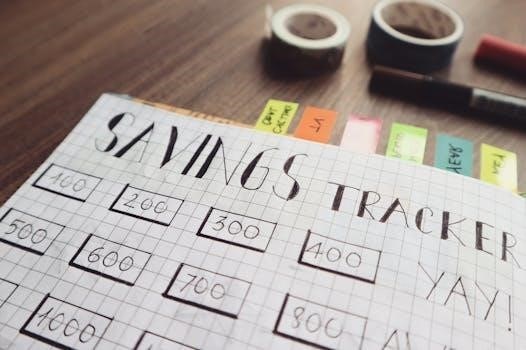
Compound probability explores the likelihood of two or more independent events occurring together. It involves combining individual probabilities to find the overall chance. This topic often uses concepts of sample space and tree diagrams to visualize all possible outcomes and their associated probabilities.
Understanding Compound Events
A compound event involves the combination of two or more simple events. These events can be either independent, where one event does not affect the outcome of another, or dependent, where the outcome of one event influences the probability of the subsequent event. For example, tossing two coins or drawing two cards from a deck without replacement are examples of compound events. Understanding the relationship between these events is crucial for calculating the overall probability. We must consider if the events can happen simultaneously or are mutually exclusive, meaning they cannot occur together. This distinction affects how we approach calculating their combined probabilities, using different formulas and methods to determine the overall likelihood of the compound event. Recognizing the simple events that make up the compound event is the first step in solving probability problems.

Types of Compound Events
Compound events are categorized into two main types⁚ independent and dependent. These categories are crucial for calculating probabilities, as different methods are applied based on the relationship between the events.
Independent Events
Independent events are those where the outcome of one event does not influence the outcome of another. For instance, flipping a coin multiple times or rolling a die are examples where previous results do not affect subsequent ones. When calculating the probability of two independent events both happening, you simply multiply the probability of each individual event. For example, the probability of getting heads on a coin flip is 1/2, and the probability of rolling a 6 on a die is 1/6. The probability of both events occurring is (1/2) * (1/6) = 1/12. Understanding the concept of independent events is fundamental in mastering compound probability. Many real-life situations, such as multiple trials in experiments, involve independent events that need to be analyzed using this principle. This calculation is based on the product rule, which is used to compute the chance of two independent events. We can see examples in games of chance, such as the lottery.
Dependent Events
Dependent events are those where the outcome of one event affects the probability of another event occurring. This often happens when events occur without replacement. A classic example is drawing cards from a deck without putting them back. If you draw a king, the probability of drawing another king on the second draw is reduced since there are fewer cards and fewer kings left. Calculating the probability of dependent events requires conditional probability. In such instances, the probability of the second event is conditional on the fact that the first event has already occurred. Understanding dependent events is crucial for real-world applications where one action influences the likelihood of a subsequent action. This calculation often needs a careful consideration of how the sample space changes with each event. The concepts are also vital in statistical analysis.

Calculating Probabilities of Compound Events
Calculating compound probabilities involves combining individual event probabilities using formulas, tree diagrams, or tables. The approach depends on whether the events are independent or dependent. It requires careful attention to the sample space;
Using Tree Diagrams
Tree diagrams are a visual tool used to map out all possible outcomes of a series of events, making them incredibly helpful for calculating compound probabilities. Each branch represents a possible outcome, and the probabilities are written along these branches. To find the probability of a specific sequence of events, you multiply the probabilities along the corresponding path of the tree. For instance, if you’re tossing a coin twice, the tree diagram would have two main branches for the first toss (heads or tails), and then each of those branches would have two more branches for the second toss. This way, you can see all four possibilities (HH, HT, TH, TT) and calculate their probabilities. Tree diagrams are particularly useful when dealing with more than two events or when events have multiple possible outcomes, offering a clear and organized way to visualize the sample space and calculate probabilities.
Using Tables
Tables provide a structured way to organize and calculate probabilities for compound events, especially when dealing with two independent events. A table, often a two-way table, lists the outcomes of one event in the rows and the outcomes of the second event in the columns. The cells within the table represent all the possible combinations of outcomes for both events. You can calculate the probability of each combined outcome by multiplying the probabilities of the individual events that make up that combination. This method works well when the events are independent, meaning the outcome of one event doesn’t affect the outcome of the other. Tables are a useful alternative to tree diagrams, particularly when the number of possible outcomes for each event is limited, making them easier to visualize and analyze. They offer a clear and organized way to determine combined probabilities.

Practice Problems and Worksheets
This section provides examples of probability problems involving compound events. Worksheets are available with practice questions and solutions to help strengthen understanding of calculating probabilities of compound events.
Examples of Compound Probability Problems
Let’s explore some examples of compound probability problems to illustrate how to calculate the likelihood of multiple events occurring together. Imagine a scenario involving a bag with 7 red, 8 green, and 6 blue marbles. What is the probability of selecting a green or blue marble? This involves finding the probability of two mutually exclusive events. Also, consider a situation with a standard deck of 52 cards. What’s the probability of drawing a 10 or a face card? Another example may involve multiple independent events, such as flipping a coin twice and getting heads then tails. Furthermore, consider the chances of drawing two red socks from a drawer without replacement. These examples demonstrate how different types of compound events are approached, including independent and dependent events, as well as mutually exclusive and non-mutually exclusive events. Tree diagrams and tables can be helpful tools to visualize these problems.
Where to Find Practice Worksheets with Answers
Finding suitable practice worksheets for compound probability is essential for mastering the concept. Many educational websites offer free downloadable PDFs with various problem sets. Look for resources that specifically target compound events, including both independent and dependent scenarios. Some websites provide worksheets categorized by difficulty level, allowing students to progressively enhance their understanding. Check for resources that include answer keys or detailed solutions, which are crucial for self-assessment and learning from mistakes. Khan Academy is a great place to learn and practice this subject, also, other educational platforms also offer comprehensive sets of worksheets with detailed explanations. Additionally, some textbook publishers may offer supplementary materials online or in physical workbooks. Ensure the worksheets you choose cover different types of compound probability problems, including those involving coins, dice, cards, and marbles. These resources are invaluable for solidifying your understanding of compound probability.

Real-World Applications
Compound probability isn’t just theoretical; it has real-world applications, from predicting weather patterns to analyzing games of chance. Understanding it is useful in many fields, including finance, risk management, and even sports strategy.
Examples of Compound Events in Everyday Life
Compound events are all around us, often without us even realizing it. Consider flipping a coin twice; the outcome of the first flip doesn’t influence the second, making it a series of independent events that create a compound probability scenario. Similarly, rolling a die multiple times is a compound event where each roll is independent. Think about drawing cards from a deck without replacement, which introduces dependency⁚ the chance of drawing a specific card changes each time. Weather forecasts often use compound probability, looking at multiple factors such as temperature and wind speed to predict rain. When you choose an outfit, picking a shirt and then pants is a compound event, where each choice can influence the overall outfit. These examples highlight how understanding compound probability helps us navigate everyday situations and make informed decisions based on likelihoods.
Leave a Reply
You must be logged in to post a comment.